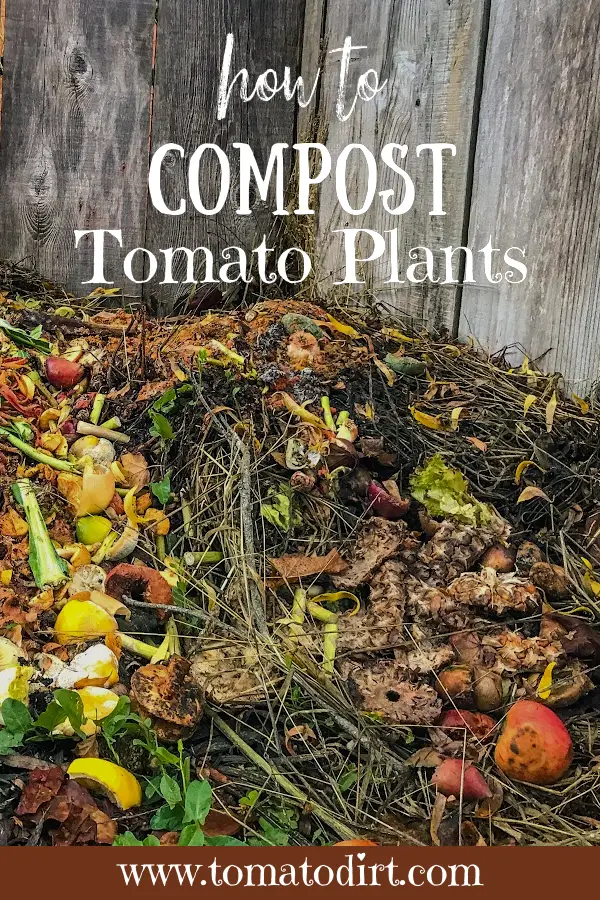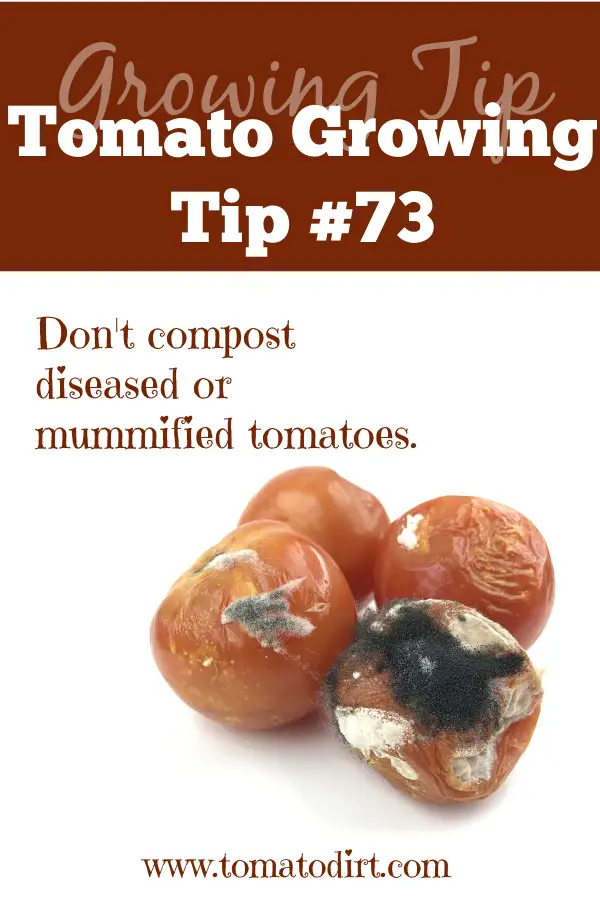FREE: 10 Must-Know Tomato Growing Tips Get The Guide
Read our affiliate disclosure here.
Can You Compost Tomato Plants?
Since 2010, Tomato Dirt has garnered 4.8+ million views, making it the web’s leading online source for growing tomatoes in the home garden. Award-winning writer and Tomato Dirt owner Kathy Widenhouse has helped thousands of home gardeners grow healthier tomatoes. Be one of them when you get Tomato Dirt’s Growing Guide here.
Updated 9.30.25
Can you compost tomato plants? The short answer: yes.
Tomato plants are a great addition to your compost pile. They provide valuable organic material that can decompose and enrich your compost.
But there are a few tips you need to know before you pull out the spent tomato plants in your garden and toss them onto the compost heap or into the refuse bin. To compost tomato plants, follow these helpful steps.
Compost tomato plants with these tips
1. Remove diseased and infected plants
As you move through your tomato patch at the end of the season, pull out any plants that were impacted by disease. Yes, that nasty case of early blight … all 5 types of tomato wilt … tomato leaf curl and gray leaf spot and even powdery mildew. You don’t want those fungi to overwinter in your luscious new compost, do you? Me, neither.
The same goes for plants that were infested with aphids, beetles, stink bugs, and other unwelcome pest guests. There’s a good chance those critters left larvae on your plants and in the immediate surrounding area.
Remove diseased and infected tomato plants and dispose of them – including their roots. If your local area allows, then burn them.
2. Dispose mummified fruit
Can you put rotten tomatoes in compost? You know … all those tomatoes that fall on the ground, get bruised, spew their seeds, turn brown, shrivel up. Don’t. They’re magnets for disease, bacteria, viruses, and fungi. Rake them together. Add them to your burn pile or discard them.
3. Gather leftover tomato plants
Collect your remaining tomato plant debris. Break, cut, or shred them into pieces to increase their surface area. That increases opportunities for microbes to work their break down magic, thereby speeding up the composting process.
If you don’t chop up your leftover plants, then there’s a bigger chance they won’t break down thoroughly in your compost pile. And who wants a shovelful of black gold laced with stringy tomato vines?
4. Add brown layers
Compost is built from two types of organic material, simply referred to as “greens” and “browns.” Greens are high in nitrogen. They include grass clippings, weeds, kitchen scraps – and tomato plants. Browns are high in carbon, like dry leaves and corn stalks.
The best compost combination is about 3-4 parts of browns to one part greens by volume. By weight, the best proportion is about 50% green (nitrogen-rich materials) and 50% brown (carbon-rich materials.) Layer your tomato plants with plenty of dry leaves and other browns, rather than dumping them on the pile or in the bin all at once.
5.
Keep compost moist
Add moisture to your tomato compost regularly – especially during a drought – so that its concentration is like a wrung-out sponge.
6. Let it breathe
Don’t want the compost to smell? Aerobic microorganisms in your compost bin or pile need air to survive and to continue their work of breaking down organic matter. Without oxygen, the decomposition process turns anaerobic and ferments.
Avoid that fragrant fate when you turn your compost pile or compost bin regularly – about every two weeks. Use a pitchfork, spade, or tractor, if your pile is quite large. If you have a compost tumbler, simply give it a whirl.
More questions about composting tomato plants
Q. When should you compost tomato plants?
- After pruning. Throughout the growing season, you may prune your tomato plants. Add those leaves, suckers, and stems to your compost pile as you go, provided they are healthy and not diseased.
- After frost or freeze. Maybe an early frost or freeze has damaged tips of your tomato plants. Trim them back and add the refuse to your compost bin.
- At season’s end. The most common time to compost tomato plants is at the end of the growing season, typically in late fall. You’ve harvested all the ripe tomatoes from your plants, along with the green ones to ripen indoors. And you’re ready to clean up your patch. Go ahead … remove your tomato plants, including the roots if possible. Add them to your compost tumbler, bin, or pile as a way to prepare for next season.
Q. Will
tomato seeds become compost, too?
Maybe. Maybe not – especially if your compost pile doesn’t heat up properly and maintain an internal temperature of over 140°F for two weeks or more. That’s how hot it’s got to get to kill seeds.
On the upside, if tomato seeds don’t decay in your pile, they can sprout into volunteer tomato seedlings in the spring. Yes, volunteers can produce perfectly healthy tomatoes. But you won’t know what variety they are. At the least, volunteers are hybrids.
Q. Can you compost tomato plants with blight?
You can. But don’t.
Early blight, late blight, Septoria leaf spot – funguses cause different kinds of tomato blight. They over winter in your soil as they prepare to invade your crop next season. If you compost tomato plants with blight, your new black gold has the chance of transferring those microorganisms to wherever you use the compost. Play it safe and destroy plants affected by tomato blight or any other disease.
Q. Can
you use tomato compost on other plants?
Yes! Once organic material breaks down, Healthy compost is rich and nutritious for all types of plants in your garden. You’ll discover there’s a good reason gardeners call it “black gold.”
More on Composting for Tomatoes
Get Started Composting In The Fall: A Quick Guide ...
4 Types of Compost Bins: Which Is Best for You?
Compost Containers For Outside: Which Is Right for You?
How to use a kitchen compost bin to make black gold ...
2 types of composting for the home gardener ...
When to compost: a guide to composting through 4 seasons...
More composting tips on our Pinterest board ...
Return from Can You Compost Tomato Plants? to Tomato Dirt home
As an Amazon Associate and Rakuten Advertising affiliate I earn from qualifying purchases.
SHARE THIS PAGE:
FREE! 10 Must-Know Tomato Growing Tips: 20-page guide
Get yours here:





